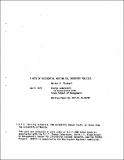A note of residential heating oil inventory policies
Author(s)
Fischer, Walter P.
DownloadMIT-EL-76-022WP-03818011.pdf (982.8Kb)
Metadata
Show full item recordAbstract
The question whether present inventory policies of residential heating
oil consumers are stable or likely to change as a result of higher oil
prices or a shortage situation is investigated on the basis of a model
which explains heating energy cost as a function of a consumer's tank
capacity, the size of oil deliveries, his choice of a safety level of
oil in his tank, and on the basis of data for Massachusetts. For the
most common situation of a consumer who owns a 270 gallon tank and
consumes 1000 to 2000 gallons per heating season, the result is: Unless the consumer expect substantial fluctuations in the price of
oil to occur during each year throughout the depreciation period of
the tank, there is little incentive to change the present inventory
policy: One 270 gallon tank and the avoidance of policies which reduce
the delivery size through partial fills or a large safety level, are
stable policies.
Description
This work was conducted in part under an M.I.T./IBM Joint Study in association with the M.I.T. Energy Laboratory, the M.I.T. Sloan School of Management's Center for Information Systems Research, and the NEEMIS Project
Date issued
1976Publisher
MIT Energy Lab
Other identifiers
03818011
Series/Report no.
MIT-EL76-022WP
Keywords
Dwellings -- Fuel consumption
Collections
The following license files are associated with this item: